In 2025, Artificial Intelligence in UX is one of the biggest influences on how users engage and experience digital platforms. There are new types of apps that are not only designed to complete tasks but also have the capacity to anticipate users' wishes, predict when users will want those wishes, and understand how AI-driven UX can deliver those experiences. This metamorphosis creates both pressure and opportunity for app-driven businesses to sell and retain customers.
Surveys show seventy-two percent of users expect their experience to be personalized in every app they use, compared to sixty-four percent two years earlier. These actions prove that individual industries do not set user expectations.
For product leaders and UX teams, AI UX design has moved from a "nice to have" support function to a prominent design element. Design leaders need to focus on aligning AI technology for improving UX design with human-centered design principles so that the technology adds to the experience rather than adding friction or confusion.
Learn more about how advanced AI tools can enhance your digital products through Artificial Intelligence Services.
AI Meets UX: Crafting Human-Centered Interactions
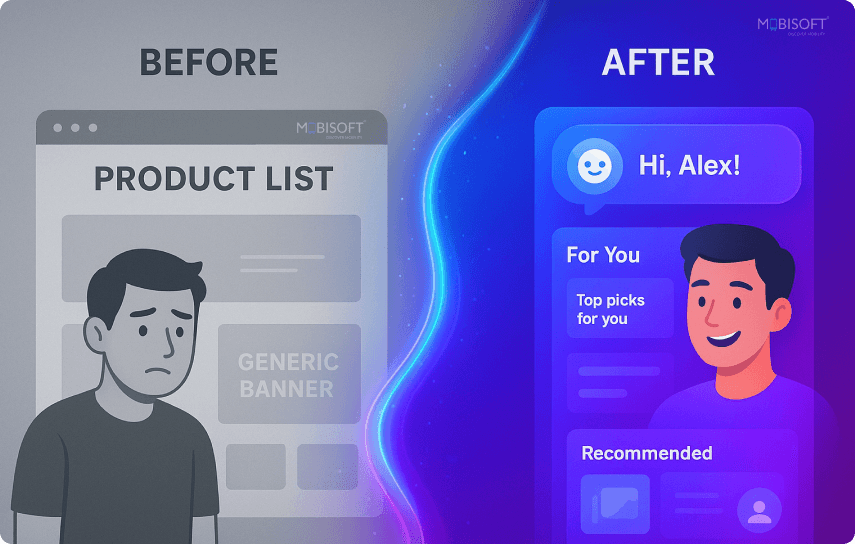
UX design with AI offers experiences that feel natural, rather than programmed. When used effectively, AI systems process large streams of behavioral data, while UX ensures that insights are translated into simple, usable flows. It is not about replacing design—it is about giving design more flexibility and intelligence.
One example is navigation within an app. An AI-powered user experience ensures personalized recommendations based on individual users’ actions. The UX layer ensures these actions fit logically within the broader interface. This partnership results in less effort on the user’s side and higher engagement for the business.
Another key area is predictive interaction. An AI-driven product experience is the result of AI that constantly analyzes choices and patterns. While the UX part ensures a seamless interaction. Together, they create an adaptive system that grows more effective with use.
Discover how to elevate your mobile experience with expert UI/UX Design for Mobile Apps.
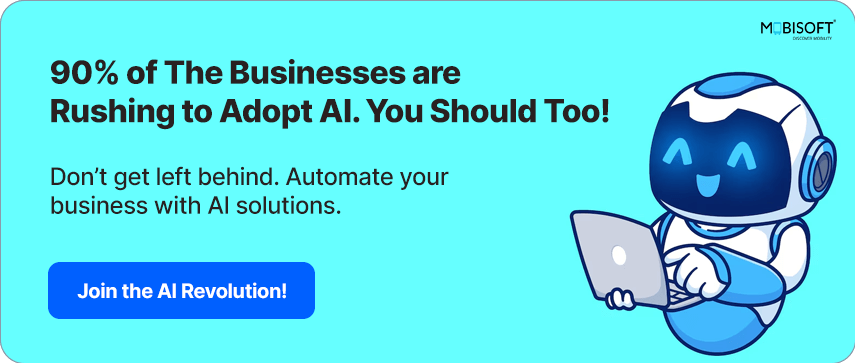
Can Apps Still Compete Without AI?
Dynamic User Expectations
By 2025, user expectations have evolved to the point where static app flows cannot meet their needs. A study conducted this year found that almost seven in ten respondents preferred apps that recognized their preferences in real time. If businesses provide only static, one‑size‑fits‑all interfaces, users will disengage quickly. AI and product design enable experiences to become fluid and dynamic, giving users personalized user experiences with AI through context-aware guidance. Without adapting, even well-designed applications feel outdated in a competitive environment.
Business Growth and Retention
AI-driven UX directly influences retention and revenue outcomes. A 2025 survey showed that 84% of respondents are using or planning to use AI tools in their development process, an increase of 76% over last year. Smart UX design fosters loyalty by anticipating needs and enabling smoother transactions. In B2B, where repeat engagement is critical, integrating AI cannot be optional. It positions products as proactive partners rather than passive systems.
Source: Stackoverflow 2025 AI Survey
Competitive Market Positioning
The future of UX design increasingly depends on AI. It is the differentiating factor in winning or losing app adoption. Treating AI as a core design strategy becomes a business advantage that secures long-term competitiveness.
Read our insights on the evolution of UX with AI UX 2025: The Rise of AX to stay ahead in digital design.
The Engines Powering AI-Driven Apps
Voice Assistants and NLP
- Voice assistants such as Siri or Google Assistant rely on AI in UX via natural language processing to interpret commands. They reduce friction and make interactions hands-free, especially valuable in on-the-go mobile use cases.
- Recent data show roughly 1 in 5 internet users worldwide now use voice commands to search online. In the US alone, over 153.5 million adults will use voice assistants in 2025. Businesses integrating voice have deduced that it shapes brand perception as efficient and modern.
Source: Voice Search Trends 2025
Recommendation Engines
- AI-driven UX recommendation systems help personalize app content by studying past behaviors. They now extend beyond retail and streaming apps, reaching finance, healthcare, and productivity tools.
- According to a 2025 survey, average app retention on Android was 21.1% at day one, dropping to 2.1% by day 30. On iOS, average app retention was 23.9% at day one, dropping to 3.7% by day 30. This proves that UX optimization with AI is necessary for apps to stay competitive.
Source: App Retention Rates (2025)
Predictive Analytics
- Predictive AI uses user behavior patterns to predict needs. Consider ride‑sharing apps - they can predict high demand times, and raise prices or drop availability before demand surges.
- The predictive analytics market in 2025 stands at around $20 billion, expected to grow at 22–28% annually over the next five years. Businesses benefit from efficiencies while providing AI-powered user experiences.
Source: State of Predictive Analytics in 2025
Chatbots and Conversational Interfaces
- AI in design thinking supports chatbots that assist users around the clock. App experiences become more reliable when users know support is instant.
- The global chatbot market is valued at $15.57 billion in 2025, with more than 987 million users. By 2029, it is expected to reach $46.64 billion.
Source: 40+ Chatbot Statistics (2025)
Multimodal AI Models
- The latest models do not just handle text but combine text, voice, and image inputs for richer interactions.
- Meta and Google’s new releases show how multimodal design can make apps context‑aware. Businesses can deliver faster onboarding and smoother task completion, which drives adoption.
Explore strategies to boost engagement through How User Experience Impacts Conversion Rates.
Adoption Rates of Key AI Tools in Mobile Apps (2025)
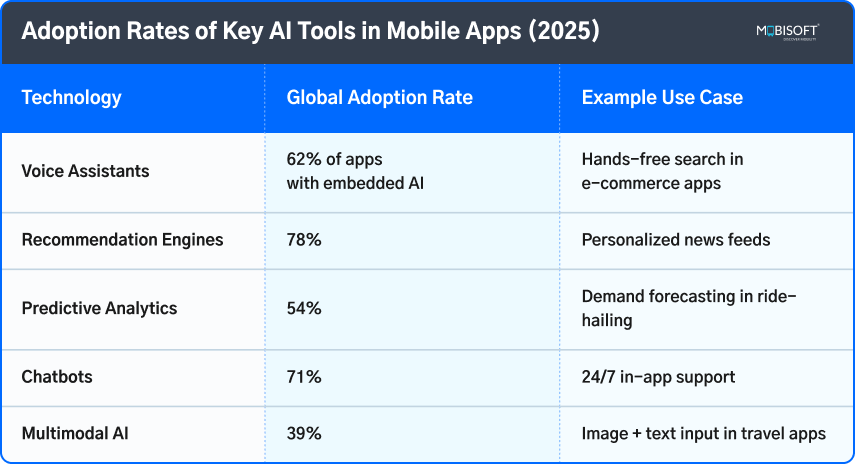
AI in Action: Industry Success Stories
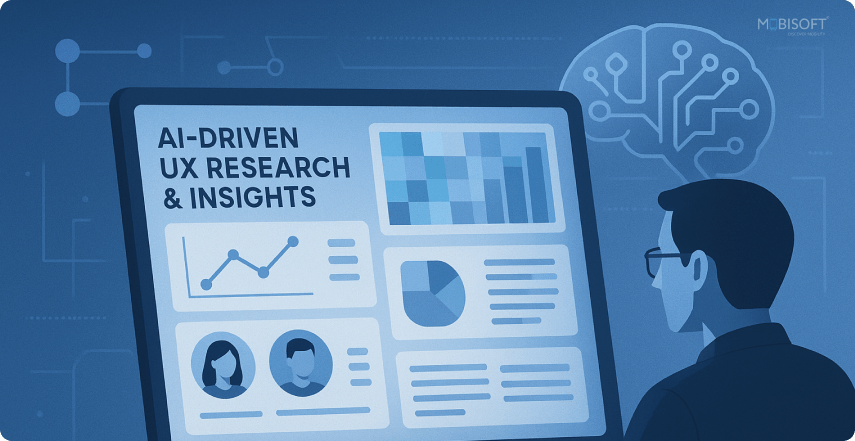
Spotify: Personalization as Core Strategy
- Spotify processes half a trillion user events daily, predicting individual music preferences with great accuracy.
- This AI-driven UX personalization powers playlists like Discover Weekly, which significantly increases user engagement and retention.
- Retention rates doubled for premium subscribers who engaged with AI-powered user experiences in Discover Weekly and Release Radar features, proving how AI in UX directly drives loyalty.
Source: How Spotify uses AI in Music
Uber: Predictive Operations in Mobility
- As of June 2025, Uber had 180 million monthly active platform consumers. Compared to a year ago (Q2 2024), the number of monthly users has increased by 15.38%.
- The new ETR (Estimated Time to Request) model at Uber offers an AI-driven product experience through predictive analytics, replacing older heuristic-based approaches.
- It offers significantly higher precision (+30%) in predicting when drivers will experience short wait times (0–15 minutes) at airport queues.
Source: Uber Statistics 2025
Duolingo: Adaptive Learning Journeys
- Since launching the AI-powered UX video-call tool for Android, Duolingo has expanded the feature to additional languages, boosting subscription growth by enabling users to practice natural conversations across a broader linguistic range.
- Revenue in the April–June period was $252.3 million, exceeding analysts’ estimates of $240.7 million.
- After taking 12 years to develop the first 100 courses, AI in UX design helped introduce 148 new courses in roughly one year.
Source: Duolingo 2025 revenue forecast
Top Sectors Benefiting from AI in Applications
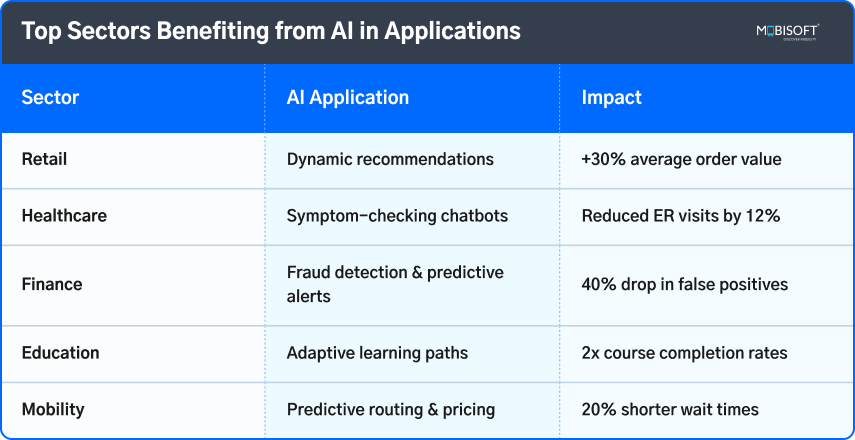
This table highlights how AI-driven UX and AI technology for improving UX design are transforming multiple industries.
The Other Side Of The Coin
Data Privacy and Security
- Data from GWI shows that 69% of users worldwide trust apps more if they clearly disclose how their data is collected and applied. Human-centered AI emphasizes transparency.
- GDPR-style compliance improves retention, with compliant apps showing 30% lower abandonment rates than non-compliant peers.
- Encryption and user control improve trust, which directly correlates with engagement scores in global surveys.
Avoiding Over‑Automation
- Cart and checkout abandonment rates across e-commerce account for 70%. This is due to unexpected policies, hidden costs, or forced registrations.
- Over-automation can reduce trust, especially if recommendations feel manipulative.
- Using UX design with AI carefully ensures personalized user experiences with AI without crossing user comfort thresholds.
Source: Abandonment Rate Statistics 2025
Preventing Ethical Misuse
- 44% of consumers say transparency about data use is the top driver of brand trust.
- Misuse of AI features led to a nineteen percent drop in user trust across affected businesses.
- Establishing ethical guardrails is critical for AI in design thinking and smart UX design, signaling responsibility and resulting in higher adoption rates among enterprise clients. Learn best practices for your web experience with UI/UX Design for Web.
User Concerns About AI in Mobile Apps (2025 survey data)
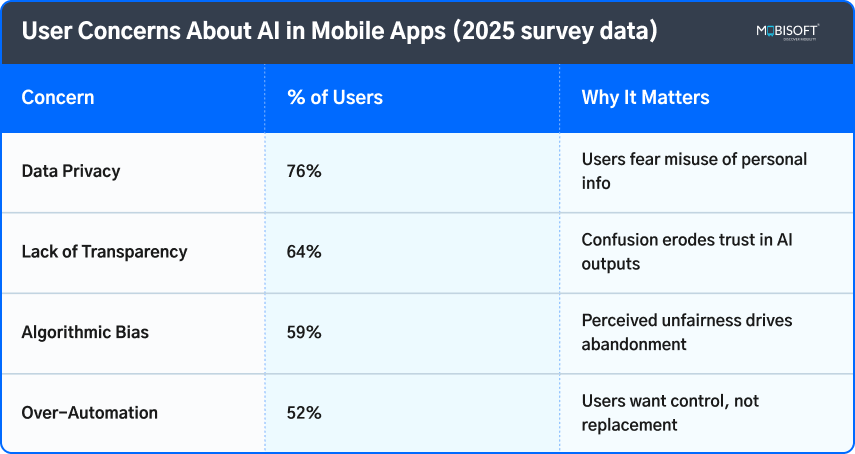
User Trust as Currency
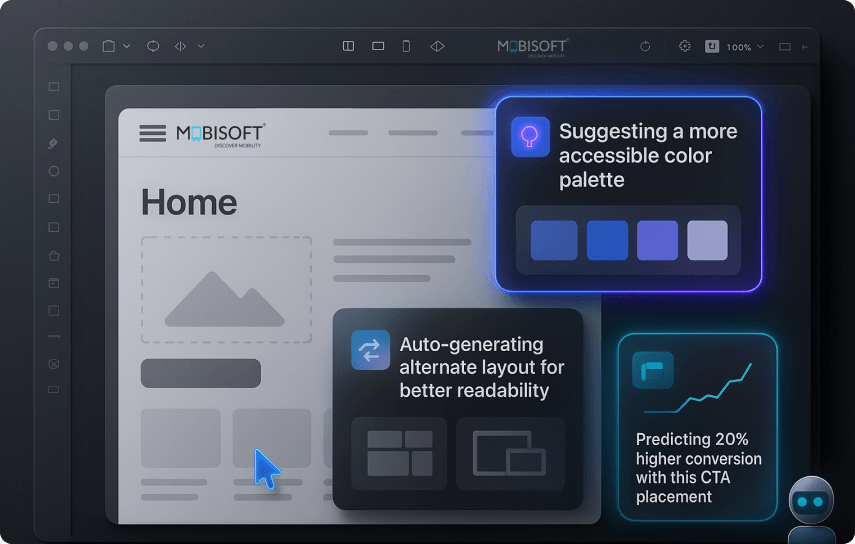
Trust has become the single most important factor in digital adoption. Many consumers express concern about AI in UX and data security, with 57% worrying about generative AI’s impact on privacy. Without trust, engagement drops sharply. Businesses that prioritize human-centered AI are rewarded with longer retention and higher lifetime value.
Source: Thales survey reveals declining trust in digital services
Compliance and Competitive Advantage
New regulatory frameworks are emerging in markets from Europe to Asia. While some see regulation as a hurdle, leading businesses use AI in design thinking as a differentiator. Meeting and exceeding legal requirements showcases reliability and stability, two features procurement teams rank highly when selecting enterprise solutions.
Avoiding Algorithmic Bias
Bias in AI output can erode brand credibility overnight. Proactive bias testing and inclusion protocols are now part of leading UX design with AI standards. This effort signals that the business values fairness alongside performance, building trust in AI-powered user experiences.
Transparency as a Design Principle
Transparency is no longer a legal checkbox but a user demand. Users are more willing to share personal data if explanation tools are provided. Businesses that integrate explainability features give users control, turning transparency into a core differentiator for mobile platforms. Smart UX design leverages transparency to foster engagement and loyalty.
Learn how to enhance your platform’s accessibility and compliance through SEO & WCAG Compliance best practices.
The Future of Apps Is AI-First
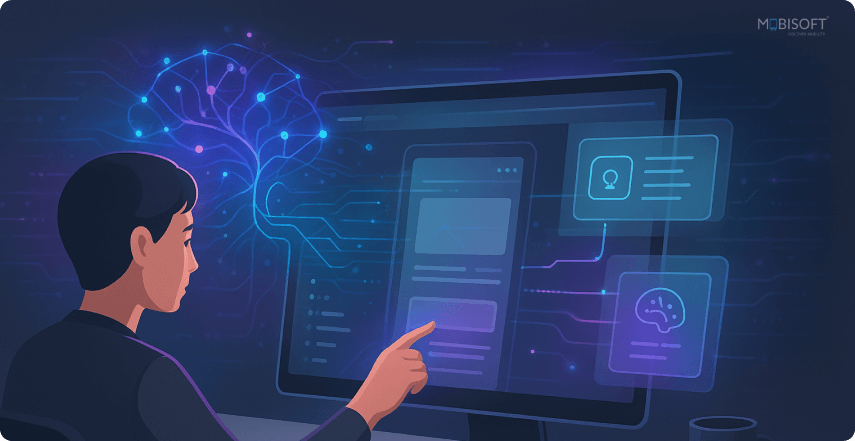
AI has moved from a supporting feature to the foundation of AI-driven product experience design. Now that users allow data collection, apps are expected to be adaptive and personalized.
AI does not supplant user experience design; it enhances it by delivering the intelligent capability for personalization in real time, predictive assistance, and every scalable method of service delivery. But as we have seen in industry after industry, successful integration of AI requires a considered alignment with human needs, transparency about what is going on, and effective ethical cover.
For enterprises, the decision is whether to consider AI a strategic design approach versus an incremental one. Those who adapt will benefit from retention (higher, as recently reported), trust (greater), and a better relative position to competitors. Get guidance on building cohesive platforms with Design System Consulting.
Key Takeaways:
- AI has become essential in app design: no longer a side feature but the foundation of user engagement in 2025.
- User expectations are rapidly evolving: personalization, predictive interaction, and adaptive flows are now baseline requirements.
- AI directly impacts business outcomes: companies report higher retention, lower churn, and stronger brand loyalty when AI is integrated effectively.
- Multiple AI technologies converge: from NLP voice assistants and recommendation engines to multimodal models, each technology improves different aspects of user experience.
- Case studies prove real-world impact: Spotify, Uber, and Duolingo show measurable growth through AI-driven personalization, predictive operations, and adaptive learning.
- Trust as digital currency: responsible AI, transparency, and compliance are now competitive advantages, as users reward trustworthy platforms with longer retention and higher lifetime value.
- Caution is necessary: privacy, bias prevention, and avoiding over-automation are critical to sustain user confidence and prevent backlash.
- Future competitive advantage hinges on AI: businesses that treat AI as a core design strategy, not an add-on, will stay relevant.


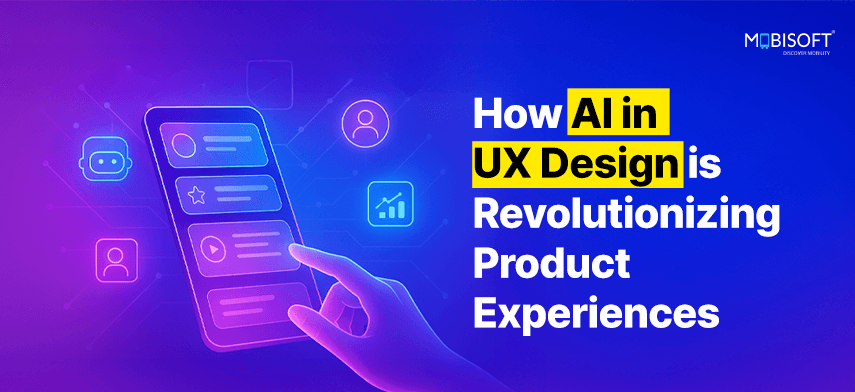


 September 12, 2025
September 12, 2025


